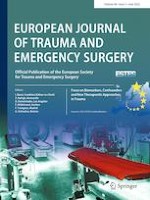Erschienen in:

22.11.2021 | Original Article
Dexmedetomidine and paralytic exposure after damage control laparotomy: risk factors for delirium? Results from the EAST SLEEP-TIME multicenter trial
verfasst von:
Cassandra Krause, Eugenia Kwon, Xian Luo-Owen, Kaitlin McArthur, Meghan Cochran-Yu, Lourdes Swentek, Sigrid Burruss, David Turay, Areg Grigorian, Jeffry Nahmias, Ahsan Butt, Adam Gutierrez, Aimee LaRiccia, Michelle Kincaid, Michele N. Fiorentino, Nina Glass, Samantha Toscano, Eric Ley, Sarah R. Lombardo, Oscar D. Guillamondegui, James M. Bardes, Connie DeLa’O, Salina M. Wydo, Kyle Leneweaver, Nicholas T. Duletzke, Jade Nunez, Simon Moradian, Joseph Posluszny, Leon Naar, Haytham Kaafarani, Heidi Kemmer, Mark J. Lieser, Alexa Dorricott, Grace Chang, Zoltan Nemeth, Kaushik Mukherjee
Erschienen in:
European Journal of Trauma and Emergency Surgery
|
Ausgabe 3/2022
Einloggen, um Zugang zu erhalten
Abstract
Purpose
To evaluate factors associated with ICU delirium in patients who underwent damage control laparotomy (DCL), with the hypothesis that benzodiazepines and paralytic infusions would be associated with increased delirium risk. We also sought to evaluate the differences in sedation practices between trauma (T) and non-trauma (NT) patients.
Methods
We reviewed retrospective data from 15 centers in the EAST SLEEP-TIME registry admitted from January 1, 2017 to December 31, 2018. We included all adults undergoing DCL, regardless of diagnosis, who had completed daily Richmond Agitation Sedation Score (RASS) and Confusion Assessment Method-ICU (CAM-ICU). We excluded patients younger than 18 years, pregnant women, prisoners and patients who died before the first re-laparotomy. Data collected included age, number of re-laparotomies after DCL, duration of paralytic infusion, duration and type of sedative and opioid infusions as well as daily CAM-ICU and RASS scores to analyze risk factors associated with the proportion of delirium-free/coma-free ICU days during the first 30 days (DF/CF-ICU-30) using multivariate linear regression.
Results
A 353 patient subset (73.2% trauma) from the overall 567-patient cohort had complete daily RASS and CAM-ICU data. NT patients were older (58.9 ± 16.0 years vs 40.5 ± 17.0 years [p < 0.001]). Mean DF/CF-ICU-30 days was 73.7 ± 96.4% for the NT and 51.3 ± 38.7% in the T patients (p = 0.030). More T patients were exposed to Midazolam, 41.3% vs 20.3% (p = 0.002). More T patients were exposed to Propofol, 91.0% vs 71.9% (p < 0.001) with longer infusion times in T compared to NT (71.2 ± 85.9 vs 48.9 ± 69.8 h [p = 0.017]). Paralytic infusions were also used more in T compared to NT, 34.8% vs 18.2% (p < 0.001). Using linear regression, dexmedetomidine infusion and paralytic infusions were associated with decreases in DF/CF-ICU-30, (− 2.78 (95%CI [− 5.54, − 0.024], p = 0.040) and (− 7.08 ([− 13.0, − 1.10], p = 0.020) respectively.
Conclusions
Although the relationship between paralytic use and delirium is well-established, the observation that dexmedetomidine exposure is independently associated with increased delirium and coma is novel and bears further study.











